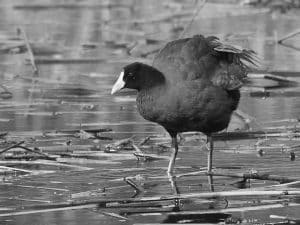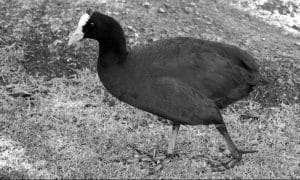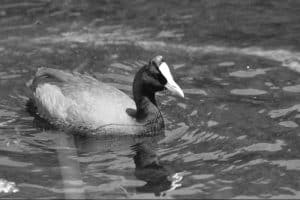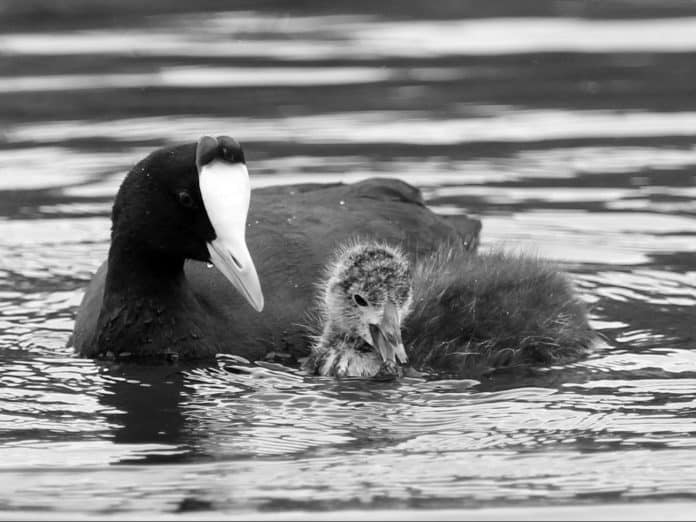Introduction to the red-knobbed coot
The red-knobbed coot in Tanzania, scientifically known as Fulica cristata, is a fascinating bird species that can be found in the beautiful wetlands of Tanzania. With its striking appearance and unique behaviors, the red-knobbed coot has earned its title as the royalty of Tanzania’s wetlands. This article will delve into the habitat, distribution, physical characteristics, and behavior of the red-knobbed coot, shedding light on the importance of wetlands for its survival and the conservation efforts being made to protect this majestic bird.
Habitat and distribution of the red-knobbed coot in Tanzania

The red-knobbed coot is primarily found in the wetlands of Tanzania, where it thrives in the lush and diverse ecosystems created by these aquatic habitats. From the Serengeti to Lake Victoria, the red-knobbed coot can be spotted in various wetland regions across Tanzania. These wetlands provide the perfect environment for the coot to feed on aquatic plants, insects, and small fish.
In Tanzania, the red-knobbed coot can be observed in both freshwater and brackish water wetlands, including lakes, swamps, and marshes. These wetlands offer abundant vegetation and open water areas, which are essential for the coot’s survival. The distribution of the red-knobbed coot extends from the western regions of Tanzania, such as Kigoma and Mwanza, to the eastern coastal areas, including Dar es Salaam and Zanzibar.
Physical characteristics and behavior of the red-knobbed coot
The red-knobbed coot is a medium-sized bird, measuring around 35-45 centimeters in length. It possesses a striking appearance with its jet-black plumage, contrasting white bill, and vibrant red knobs on its forehead. These distinctive red knobs are more prominent in males and play a role in courtship displays and territorial behavior.
This bird species exhibits fascinating behaviors, including territoriality and cooperative breeding. Red-knobbed coots are known for their aggressive defense of their nesting territories, often engaging in aggressive displays and vocalizations to protect their space. They also engage in cooperative breeding, with multiple individuals helping to raise the young, which is a unique trait among bird species.
The red-knobbed coot is a proficient swimmer and diver, using its lobed feet and strong wings to navigate through the water. It feeds on a variety of plant matter, such as aquatic vegetation and algae, as well as small invertebrates and fish. Their diet is well-adapted to the wetland environment, allowing them to thrive in these habitats.
Importance of wetlands for the red-knobbed coot
Wetlands play a crucial role in the survival of the red-knobbed coot. These unique habitats provide the coot with abundant food resources and suitable nesting sites. The wetlands of Tanzania offer a diverse range of vegetation, including submerged plants, emergent plants, and floating plants, which serve as a vital food source for the coot.
Furthermore, wetlands provide safe breeding grounds for the red-knobbed coot. The dense vegetation and shallow waters offer protection against predators, allowing the coot to successfully raise its young. Wetlands also act as a natural filtration system, purifying water and maintaining the overall health of the ecosystem, which indirectly benefits the red-knobbed coot and other bird species.
The red-knobbed coot is an indicator species, meaning its presence or absence can indicate the overall health of wetland ecosystems. By conserving wetlands, we not only protect the red-knobbed coot but also ensure the preservation of a wide range of other flora and fauna that rely on these valuable habitats.
Threats and conservation efforts for the red-knobbed coot in Tanzania

Despite the importance of wetlands for the red-knobbed coot, these habitats face numerous threats in Tanzania. Habitat loss due to human activities, such as urbanization, agriculture, and drainage for land reclamation, poses a significant challenge to the survival of the coot. Pollution from agricultural runoff and the introduction of invasive species also disrupt the delicate balance of wetland ecosystems.
To address these threats and protect the red-knobbed coot, conservation efforts are being implemented in Tanzania. These efforts involve the establishment of protected areas and wetland reserves, where the coot and other wetland species can thrive undisturbed. Additionally, awareness campaigns and education programs are raising public understanding of the importance of wetlands and the need for their conservation.
Collaborative initiatives involving local communities, government agencies, and non-profit organizations are crucial for the success of conservation efforts. By engaging stakeholders and promoting sustainable practices, we can ensure the long-term survival of the red-knobbed coot and the preservation of Tanzania’s wetland ecosystems.
How to spot and photograph the red-knobbed coot in Tanzania
Spotting and photographing the red-knobbed coot in Tanzania can be a rewarding experience for bird enthusiasts and nature photographers. To increase your chances of encountering this majestic bird, head to the wetlands during the early morning or late afternoon when the coots are most active.
Look for areas with dense vegetation and open water, as these are preferred habitats for the red-knobbed coot. Patience is key, as the coots may be initially cautious but will eventually reveal themselves as they go about their daily activities. Be mindful of your presence and maintain a respectful distance to avoid disturbing the birds or their nesting sites.
When photographing the red-knobbed coot, take advantage of natural lighting conditions and capture their vibrant plumage and unique behaviors. Zoom lenses can be useful for capturing close-up shots of the coot’s distinctive red knobs and intricate feather patterns. Remember to respect the welfare of the birds and the environment by adhering to ethical photography practices.
Other bird species found in the wetlands of Tanzania
Tanzania’s wetlands are not only home to the red-knobbed coot but also host a diverse array of bird species. These wetland habitats attract migratory birds, waterfowl, and other resident species, creating a haven for avian biodiversity. Some notable bird species found in the wetlands of Tanzania include the African fish eagle, yellow-billed stork, grey crowned crane, and black-headed heron.
Birdwatchers visiting Tanzania’s wetlands can enjoy observing and photographing these magnificent species, adding to their wildlife encounters and contributing to their knowledge of avian ecology. The wetlands truly serve as a paradise for bird lovers, showcasing the beauty and diversity of Tanzania’s avifauna.
The role of the red-knobbed coot in the ecosystem
The red-knobbed coot plays a vital role in the wetland ecosystem of Tanzania. As a herbivore, the coot contributes to the balance of the ecosystem by feeding on aquatic plants, controlling their growth, and preventing excessive vegetation that can impede water flow. This feeding behavior also aids in nutrient cycling within the wetland, enriching the soil and promoting the growth of other plant species.
Additionally, the red-knobbed coot serves as a prey species for various predators, including birds of prey and large mammals. Its presence in the food chain provides a valuable food source for these predators, helping to maintain the overall biodiversity and ecological stability of the wetland ecosystem.
The coot’s nesting activities also contribute to the ecosystem by creating microhabitats for other wetland organisms. The nest structures built by the coot, often floating or elevated above the water, provide shelter and breeding sites for small fish, amphibians, and invertebrates.
Red-knobbed coot research and monitoring projects in Tanzania

To better understand and conserve the red-knobbed coot, research and monitoring projects are being conducted in Tanzania. These projects aim to gather data on the coot’s population dynamics, breeding behavior, migration patterns, and habitat preferences. By studying the coot, scientists can gain insights into its ecological role and the factors influencing its survival.
Research findings contribute to the development of effective conservation strategies and management plans for the red-knobbed coot and its wetland habitats. Monitoring projects track population trends and assess the success of conservation efforts. These initiatives are vital for ensuring the long-term conservation of the red-knobbed coot and maintaining the ecological balance of Tanzania’s wetlands.
Conclusion: Appreciating the beauty and significance of the red-knobbed coot in Tanzania’s wetlands
The red-knobbed coot is a true symbol of the royalty found in Tanzania’s wetlands. Its striking appearance, unique behaviors, and ecological importance make it a fascinating bird species worth appreciating and conserving. By understanding the habitat, distribution, physical characteristics, and behavior of the red-knobbed coot, we can develop a deeper connection with this majestic bird and recognize the significance of wetlands in its survival.
It is our responsibility to protect the red-knobbed coot and its wetland habitats from threats such as habitat loss and pollution. Through conservation efforts, research, and responsible ecotourism practices, we can ensure that future generations have the opportunity to witness the beauty of the red-knobbed coot in Tanzania’s wetlands. Let us cherish and preserve this royal bird and the invaluable ecosystems it calls home.


































